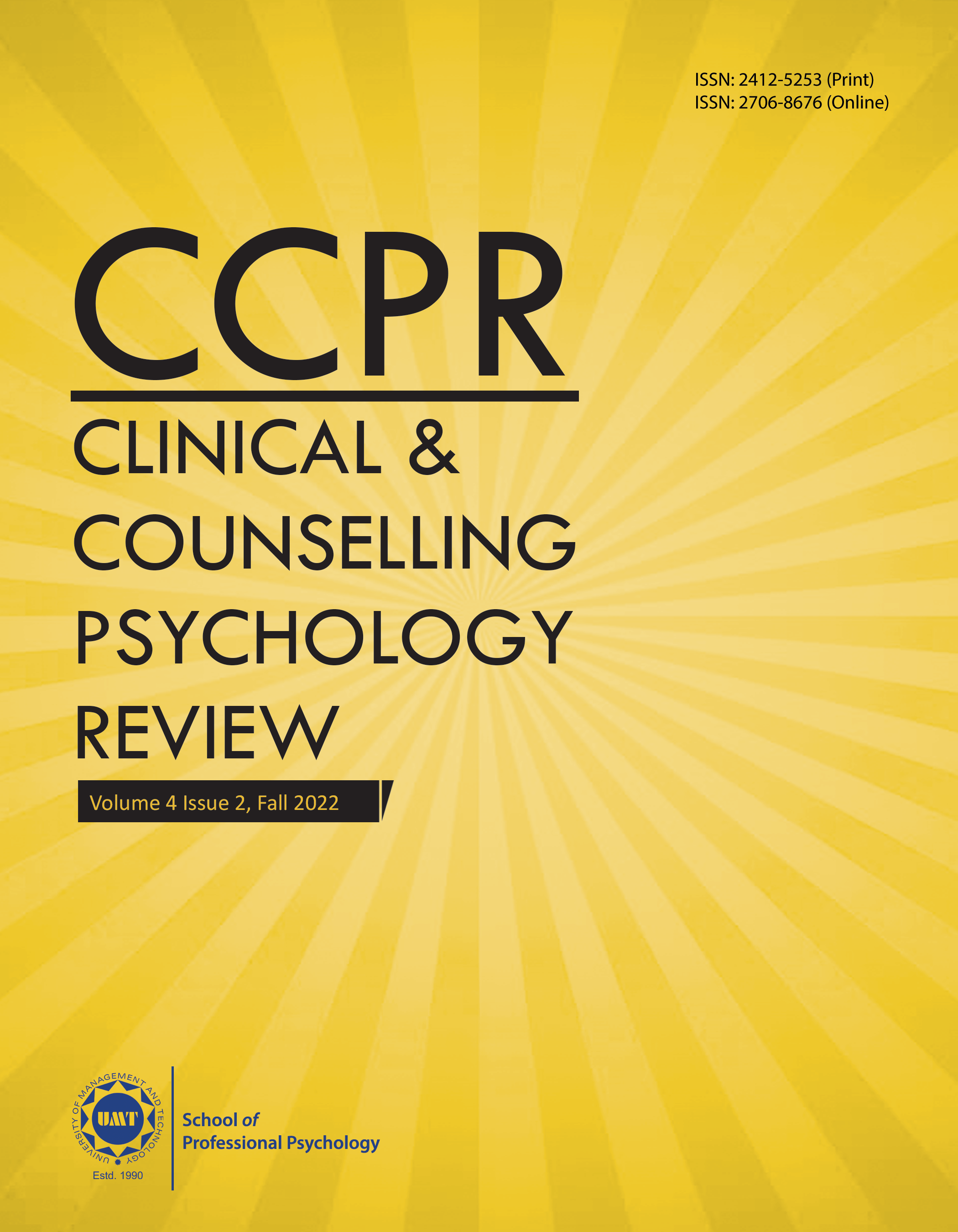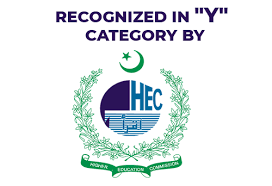Urdu Translation and Validation of Secondary Traumatic Stress Scale among Frontliners during Covid-19
Abstract
 Abstract Views: 80
Abstract Views: 80
Abstract
A cross sectional study was conducted from April, 2021 till July, 2021. The study has consisted of two phases. The first phase was comprised of translation of scale in the Urdu language following guidelines provided by WHO. Whereas in the second phase psychometric properties of the scale have been established in two parts. In the first step of study the Urdu translated scale was distributed among 290 frontliners (doctors and paramedics) who can read Urdu. The mean age was 35.14 SD= 8.94. In the second step of study 120 participants (frontline nurses) were included. The mean age was 35.82 SD= 9.01 Result of Kaiser-Guttman’s and Cattell’s scree plot suggest that only one principal component emerged with minimum 0.50 factor loading. Item total correlation ranged from .68 to .75. Cronbach’s alpha was 0.94. Test-retest reliability of scale was 0.86. For convergent validity correlation coefficient with the perceived stress scale was .83 and with depression, anxiety and stress scale was 0.77, 0.73, and 0.74 respectively that showed significant positive relationship among constructs of scales. For discriminant validity correlation coefficient with satisfaction with life scale was -.26 suggesting a weak correlation among both constructs .On Language equivalence for both scales (English and Urdu version) have strong correlation of 0.94. Reliability and validity coefficients suggest that Urdu version of Secondary traumatic stress scale (STSS) is reliable and valid scale.
Downloads
References
Adami, E., & Pinto, S. R. (2019). Meaning-(re) making in a world of untranslated signs: Towards a research agenda on multimodality, culture, and translation. In M. Boria, Á. Carreres, M. Noriega-Sánchez, & M. Tomalin (Eds.), Translation and Multimodality (pp. 71-93). Rutledge.
Aslam, N., & Kamal, A. (2017). Translation, validation and effectiveness of depression, anxiety and stress scale (DASS-21) in assessing the psychological distress among flood affected individuals. Journal of Pakistan Psychiatric Society, 14(4), 16–20.
Barki, N., Choudhry, F. R., & Munawar, K. (2020). The satisfaction with life scale: Psychometric properties in Pakistani population. Medical Journal of the Islamic Republic of Iran, 34, e159. https://doi.org/10.47176/mjiri.34.159
Bride, B. E., Robinson, M. M., Yegidis, B., & Figley, C. R. (2004). Development and validation of the secondary traumatic stress scale. Research on Social Work Practice, 14(1), 27–35. https://doi.org/10.1177/1049731503254106
Brooks, S. K., Webster, R. K., Smith, L. E., Woodland, L., Wessely, S., Greenberg, N., & Rubin, G. J. (2020). The psychological impact of quarantine and how to reduce it: Rapid review of the evidence. The Lancet, 395(10227), 912–920. https://doi.org/10.1016/S0140-6736(20)30460-8
Carmines, E. G., & Zeller, R. A. (1974). On establishing the empirical dimensionality of theoretical terms: An analytical example. Political Methodology, 1(4), 75–96. https://www.jstor.org/stable/25791395
De Vaus, D. (2004). Structured questionnaires and interviews. In V. Minichiello (Ed,). Handbook of research methods for nursing and health science. Pearson Education.
Dutheil, F., Baker, J. S., & Navel, V. (2020). COVID-19 as a factor influencing air pollution? Environmental Pollution, 263, e114466. https://doi.org/10.1016/j.envpol.2020.114466
Gavin, B., Lyne, J., & McNicholas, F. (2020). Mental health and the COVID-19 pandemic. Irish Journal of Psychological Medicine, 37(3), 156–158. https://doi.org/10.1017/ipm.2020.72
He, Y., Liu, Z., Zhang, J., Yao, J., Xiao, H., & Wan, H. (2022). Validity and reliability of the secondary traumatic stress scale: Chinese Version. Frontiers in Surgery, 9, e882712 https://doi.org/10.3389/fsurg.2022.882712
Henry, B. M., De Oliveira, M. H. S., Benoit, S., Plebani, M., & Lippi, G. (2020). Hematologic, biochemical and immune biomarker abnormalities associated with severe illness and mortality in coronavirus disease 2019 (COVID-19): A meta-analysis. Clinical Chemistry and Laboratory Medicine (CCLM), 58(7), 1021–1028. https://doi.org/10.1515/cclm-2020-0369
Kim, Y. Y. (2017). Cross-cultural adaptation. In Oxford Research Encyclopedia of Communication. Oxford. https://doi.org/10.1093/acrefore/9780190228613.013.21
Li, Q., Guan, X., Wu, P., Wang, X., Zhou, L., Tong, Y., Ren, R., Leung, K. S. M., Lau, E. H. Y., Wong, J. Y., Xing, X., Xiang, N., Wu, Y., Li, C., Chen, Q., Li, D., Liu, T., Zhao, J., Liu, M.,... & Feng, Z. (2020). Early transmission dynamics in Wuhan, China, of novel coronavirus–infected pneumonia. New England Journal of Medicine, 382, 1199–1207. https://doi.org/10.1056/NEJMoa2001316
Liu, L., Wang, W., Sun, S., Qian, J., Sun, Y., & Yu, X. (2022). Interventions to reduce post-traumatic stress disorder symptoms in health care professionals from 2011 to 2021: A scoping review. BMJ open, 12(1), e058214.
Mahmood, Q. K., Jafree, S. R., Jalil, A., Nadir, S. M. H., & Fischer, F. (2021). Anxiety amongst physicians during COVID-19: Cross-sectional study in Pakistan. BMC Public Health, 21(1), 1–10. https://doi.org/10.1186/s12889-020-10134-4
Mancini, M. N. (2019). Development and validation of the secondary traumatic stress scale in a sample of social media users [Doctoral dissertation, Cleveland State University]. OhioLINK. https://etd.ohiolink.edu/apexprod/rws_olink/r/1501/10?clear=10&p10_accession_num=csu1560443336023163
Mariam, A., Sarwar, A., Maqsood, R., Bashir, A., & Aamir, K. (2011). Translation and adaptation of “Perceived Stress Scale (PSS10)” in Urdu Language.
Maunder, R. G., Lancee, W. J., Balderson, K. E., Bennett, J. P., Borgundvaag, B., Evans, S., Fernandes, C. M. B., Goldbloom, D. S., Gupta, M., Hunter, J. J., Hall, L. M., Nagle, L. M., Pain, C., Peczeniuk, S. S., Raymond, G., Read, N., Rourke, S. B., Steinberg, R. J., Stewart, T. E.,…Wasylenki, D. A. (2006). Long-term psychological and occupational effects of providing hospital healthcare during SARS outbreak. Emerging Infectious Diseases, 12(12), 1924–1932. https://doi.org/10.3201/eid1212.060584
Memon, Z., Qureshi, S., & Memon, B. R. (2021). Assessing the role of quarantine and isolation as control strategies for COVID-19 outbreak: A case study. Chaos, Solitons & Fractals, 144, e110655. https://doi.org/10.1016/j.chaos.2021.110655
Riaz, S., Tariq, S. A. B. R. I. N. A., Mirza, U. T., Khan, M. T., Chaudhary, S. H. A. B. A. N. A., & Arshad, M. U. H. A. M. M. A. D. (2021). The feelings & perceptions of a Medical doctor after recovery from Corona infection. Pakistan Journal of Medical & Health Sciences, 15(5), 939–942. https://doi.org/10.53350/pjmhs21155939
Streiner, D. L., Norman, G. R., & Cairney, J. (2015). Health measurement scales: A practical guide to their development and use. Oxford University Press. https://doi.org/10.1093/med/9780199685219.001.0001
Tang, S. T., & Dixon, J. (2002). Instrument translation and evaluation of equivalence and psychometric properties: The Chinese Sense of Coherence Scale. Journal of Nursing Measurement, 10(1), 59–76. https://doi.org/10.1891/jnum.10.1.59.52544
Ullah, I., Khan, K. S., Ali, I., Ullah, A. R., Mukhtar, S., de Filippis, R., & Asghar, M. S. (2022). Depression and anxiety among Pakistani healthcare workers amid COVID-19 pandemic: A qualitative study. Annals of Medicine and Surgery, 78, e103863. https://doi.org/10.1016/j.amsu.2022.103863
Course Hero. (2015). WHO: Process of translation and adaptation of instruments. Course Hero. https://www.coursehero.com/file/30372721/WHO-Process-of-translation-and-adaptation-of-instrumentspdf/
World Health Organization. (2020). Coronavirus disease (COVID-19), 21 September 2020. WHO. https://apps.who.int/iris/handle/10665/334383








